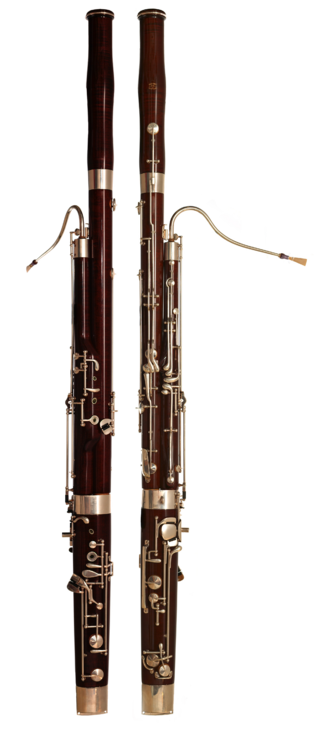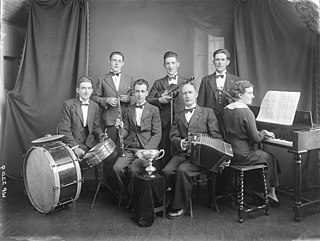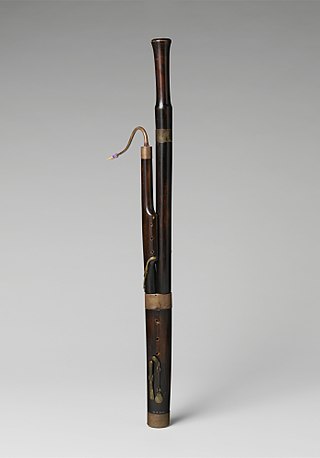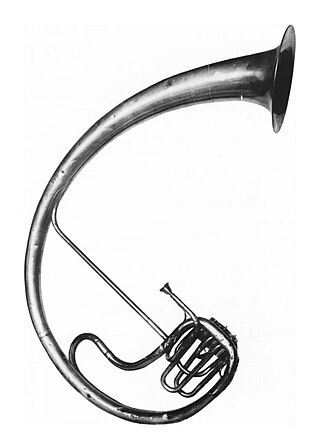
The bassoon is a woodwind instrument in the woodwind family, which plays in the tenor and bass ranges. It is composed of six pieces, and is usually made of wood. It is known for its distinctive tone color, wide range, versatility, and virtuosity. It is a non-transposing instrument and typically its music is written in the bass and tenor clefs, and sometimes in the treble. There are two forms of modern bassoon: the Buffet and Heckel systems. It is typically played while sitting using a seat strap, but can be played while standing if the player has a harness to hold the instrument. Sound is produced by rolling both lips over the reed and blowing direct air pressure to cause the reed to vibrate. Its fingering system can be quite complex when compared to those of other instruments. Appearing in its modern form in the 19th century, the bassoon figures prominently in orchestral, concert band, and chamber music literature, and is occasionally heard in pop, rock, and jazz settings as well. One who plays a bassoon is called a bassoonist.

The oboe is a type of double reed woodwind instrument. Oboes are usually made of wood, but may also be made of synthetic materials, such as plastic, resin, or hybrid composites.

Orchestration is the study or practice of writing music for an orchestra or of adapting music composed for another medium for an orchestra. Also called "instrumentation", orchestration is the assignment of different instruments to play the different parts of a musical work. For example, a work for solo piano could be adapted and orchestrated so that an orchestra could perform the piece, or a concert band piece could be orchestrated for a symphony orchestra.

The cor anglais, or English horn is a double-reed woodwind instrument in the oboe family. It is approximately one and a half times the length of an oboe, making it essentially an alto oboe in F.

The sarrusophones are a family of metal double reed conical bore woodwind instruments patented and first manufactured by French instrument maker Pierre-Louis Gautrot in 1856. Gautrot named the sarrusophone after French bandmaster Pierre-Auguste Sarrus (1813–1876), whom he credited with the concept of the instrument, though it is not clear whether Sarrus benefited financially. The instruments were intended for military bands, to serve as replacements for oboes and bassoons which at the time lacked the carrying power required for outdoor marching music. Although originally designed as double-reed instruments, single-reed mouthpieces were later developed for use with the larger bass and contrabass sarrusophones.

The contrabassoon, also known as the double bassoon, is a larger version of the bassoon, sounding an octave lower. Its technique is similar to its smaller cousin, with a few notable differences.
The heckelphone is a musical instrument invented by Wilhelm Heckel and his sons. The idea to create the instrument was initiated by Richard Wagner, who suggested its concept at the occasion of a visit of Wilhelm Heckel in 1879. Introduced in 1904, it is similar to the oboe but, like the bass oboe, pitched an octave lower, the heckelphone having a significantly larger bore.
Contrabass refers to several musical instruments of very low pitch—generally one octave below bass register instruments. While the term most commonly refers to the double bass, many other instruments in the contrabass register exist.

A septet is a formation containing exactly seven members. It is commonly associated with musical groups but can be applied to any situation where seven similar or related objects are considered a single unit, such as a seven-line stanza of poetry. In jazz, a septet is any group of seven players, usually containing a drum set, string bass or electric bass, and groups of one or two of the following instruments, guitar, piano, trumpet, saxophone, clarinet, or trombone. See, for example, Miles Davis, and Chick Corea's 1984 album, Septet.

The contra-alto clarinet, E♭ contrabass clarinet, is a large clarinet pitched a perfect fifth below the B♭ bass clarinet. It is a transposing instrument in E♭ sounding an octave and a major sixth below its written pitch, between the bass clarinet and the B♭ contrabass clarinet.
The bass oboe or baritone oboe is a double reed instrument in the woodwind family. It is essentially twice the size of a regular (soprano) oboe so it sounds an octave lower; it has a deep, full tone somewhat akin to that of its higher-pitched cousin, the English horn. The bass oboe is notated in the treble clef, sounding one octave lower than written. Its lowest sounding note is B2 (in scientific pitch notation), one octave and a semitone below middle C, although an extension with an additional key may be inserted between the lower joint and bell of the instrument in order to produce a low B♭2. The instrument's bocal or crook first curves away from and then toward the player (unlike the bocal/crook of the English horn and oboe d'amore), looking rather like a flattened metal question mark; another crook design resembles the shape of a bass clarinet neckpiece. The bass oboe uses its own double reed, similar to but larger than that of the English horn. compared to the bassoon
The alto clarinet is a woodwind instrument of the clarinet family. It is a transposing instrument pitched in the key of E♭, though instruments in F have been made. In size it lies between the soprano clarinet and the bass clarinet. It bears a greater resemblance to the bass clarinet in that it typically has a straight body, but a curved neck and bell made of metal. All-metal alto clarinets also exist. In appearance it strongly resembles the basset horn, but usually differs in three respects: it is pitched a whole step lower, it lacks an extended lower range, and it has a wider bore than many basset horns.
In music, instrumentation is the particular combination of musical instruments employed in a composition, and the properties of those instruments individually. Instrumentation is sometimes used as a synonym for orchestration. This juxtaposition of the two terms was first made in 1843 by Hector Berlioz in his Grand traité d'instrumentation et d'orchestration modernes, and various attempts have since been made to differentiate them. Instrumentation is a more general term referring to an orchestrator's, composer's or arranger's selection of instruments in varying combinations, or even a choice made by the performers for a particular performance, as opposed to the narrower sense of orchestration, which is the act of scoring for orchestra a work originally written for a solo instrument or smaller group of instruments.

The octobass is an extremely large and rare bowed string instrument that was first built around 1850 in Paris by the French luthier Jean-Baptiste Vuillaume (1798–1875). It has three strings and is essentially a larger version of the double bass – the specimen in the collection of the Musée de la Musique in Paris measures 3.48 metres in length, whereas a full-size double bass is generally approximately 2 m in length.
Pommer or bombard describes the alto, tenor, bass, and contrabass members of the shawm or Schalmey family, which are similar in function to the modern cor anglais, tenoroon, bassoon, and contrabassoon, although the bassoon family's direct ancestor was the dulcian/curtal family.

The tenor bassoon or tenoroon is a member of the bassoon family of double reed woodwind instruments. Similar to the alto bassoon, also called octave bassoon, it is relatively rare.

Grand traité d’instrumentation et d’orchestration modernes, abbreviated in English as the Treatise on Instrumentation is a technical study of Western musical instruments written by Hector Berlioz. It was first published in 1844 after being serialised in many parts prior to this date and had a chapter added by Berlioz on conducting in 1855.

The saxotromba is a valved brass instrument invented by the Belgian instrument-maker Adolphe Sax around 1844. It was designed for the mounted bands of the French military, probably as a substitute for the French horn. The saxotrombas comprised a family of half-tube instruments of different pitches. By about 1867 the saxotromba was no longer being used by the French military, but specimens of various sizes continued to be manufactured until the early decades of the twentieth century, during which time the instrument made sporadic appearances in the opera house, both in the pit and on stage. The instrument is often confused with the closely related saxhorn.

The saxtuba is an obsolete valved brasswind instrument conceived by the Belgian instrument-maker Adolphe Sax around 1845. The design of the instrument was inspired by the ancient Roman cornu and tuba. The saxtubas, which comprised a family of half-tube and whole-tube instruments of varying pitches, were first employed in Fromental Halévy's opera Le Juif errant in 1852. Their only other public appearance of note was at a military ceremony on the Champ de Mars in Paris in the same year. The term "saxtuba" may also refer to the bass saxhorn.
The Duet-Concertino for clarinet and bassoon, TrV 293, with string orchestra and harp in F major, was written by Richard Strauss in 1946/47 and premiered in 1948. It is the last purely instrumental work he wrote.














